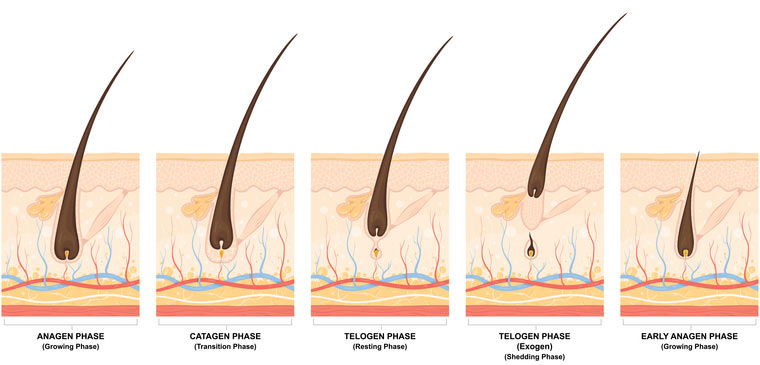Understanding the hair growth cycle is key to optimizing hair growth stages and reducing hair shedding.
Have you ever considered why some people can grow hair past their waist, while others can’t grow hair past their shoulders? Or why you need to cut the hair on your head, but not the hair on your arms? Or maybe you’ve wondered if losing hair in the shower is normal or if it’s something to be concerned about.
Keep reading to learn about the hair growth cycle and answer these questions once and for all!
Hair grows from the follicle, or root, underneath the skin. The hair is ‘fed’ by blood vessels at the base of the follicle, which gives it the nourishment it needs to grow.
Between starting to grow and falling out years later, each hair passes through four stages: anagen, catagen, telogen, and exogen.
Every hair can be at a different stage of the growth cycle at any given time.
Over time, the length of the anagen stage decreases. Therefore, the hair may become weaker and thinner after each cycle.
That’s why it’s important to ensure your diet is rich in specific nutrients to maintain healthy hair growth.

The anagen, or growing, a phase is the first part of the hair growth cycle. During this phase, cells of the bulb divide rapidly, resulting in new hair growth. Eighty to 90% of hair follicles are in the anagen phase at any given time. Minoxidil hair regrowth works on this phase.
After the hair growth phase enters the catagen phase. This short, transitional phase only lasts two to three weeks. During this, the hair stops growing and detaches itself from the blood supply. The hair becomes what is known as a club hair.
The telogen, or resting, phase follows the transition phase. During this phase, the club hair rests while a new hair begins to grow beneath it. This new hair will eventually take the place of the club hair. The telogen phase lasts for three months, and 10-15% of all hairs are in this phase at any one time.
The exogen or hair shedding phase is the last part of the hair cycle. During this, the resting club hair detaches and falls out.
Every hair eventually sheds, and it’s completely normal to lose 50 to 100 hairs each day.
In fact, the exogen phase is why you’ll frequently see hairs in your shower drain or on your hairbrush. You should only be concerned if there’s a sudden change and many more hairs than usual are falling out.
Minoxidil is thought to induce an early anagen phase when it’s applied to your scalp, meaning it can cause hair follicles to go through the rest of the growth process prematurely before starting to grow again.
This is why some people experience hair shedding when they first start using minoxidil. As hair follicles go through the growth process and enter into the anagen phase, old hairs can fall out in large numbers, making it seem as if you’re losing more hair than normal.
Since minoxidil can start afresh anagen phase for some of your hair follicles, it usually takes several months before you’ll notice any effects on hair growth.
Most studies indicate that the results from minoxidil usually start to show after six months, with few or no visible results in the first three months of use. There are also studies that don’t show any results after three months, indicating that minoxidil can take some time to start working.
In one clinical study, 26% of men reported moderate to dense hair regrowth after using a 2% minoxidil topical treatment for 4 months. This shows that minoxidil does work if you’re patient and willing to use it consistently.
In conclusion, minoxidil starts working immediately but won’t produce any noticeable results for the first three to six months. After six months, you should start to see some improvement, with the “final” results usually visible after approximately one year of continuous usage.
Minoxidil precision spray is a hair loss and hair regrowth treatment that’s widely used to treat male pattern hair loss and female hair thinning.